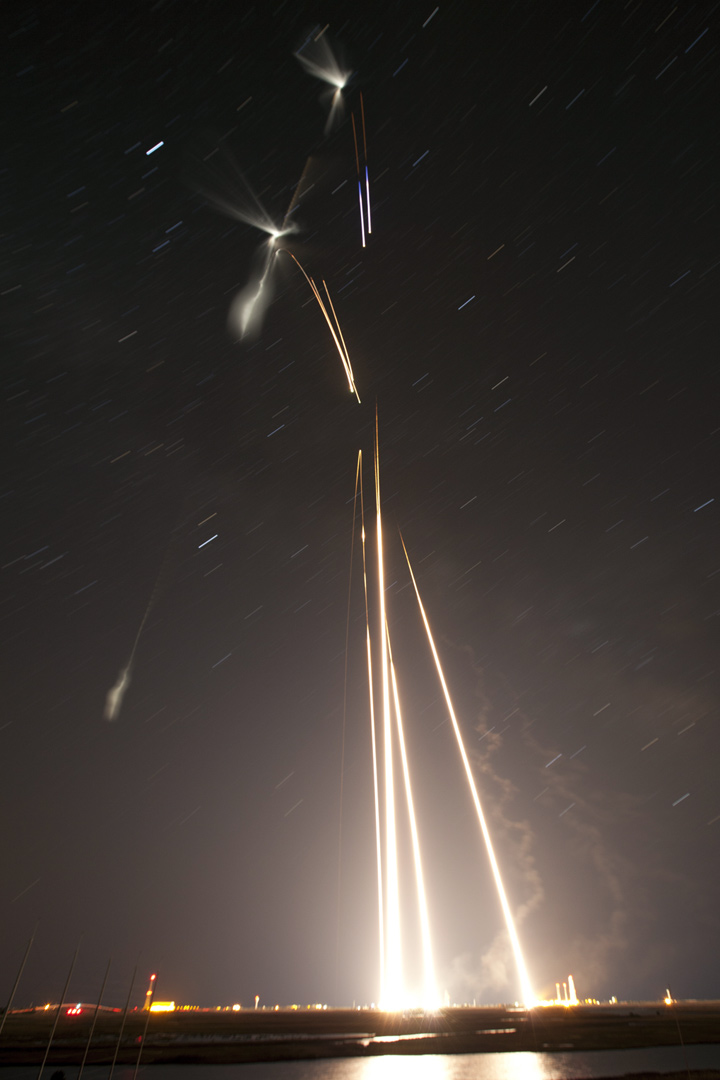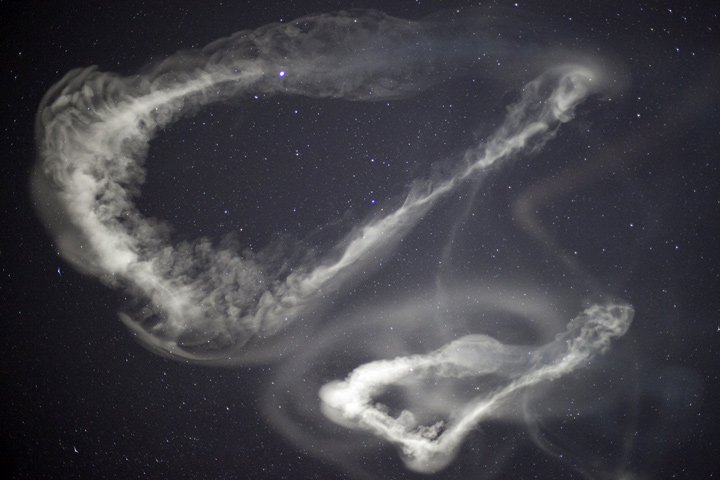NASA Earth Observatory | 2012 Mar 28
Five sounding rockets streaked into the pre-dawn sky on March 27, 2012, leaving trails of milky white clouds in a little understood part of the atmosphere. The first rocket was launched to the cusp of space at 4:58 a.m. Eastern Daylight Time, and the subsequent launches occurred at 80 second intervals. The goal of the Anomalous Transport Rocket Experiment (ATREX) was to improve understanding of the process that drives fast-moving winds high in the thermosphere.
Fiery trails from four of the five sounding rockets are clearly visible in this time-lapse photograph (top) of the launch. The second image shows two of the clouds left in the wake of the experiment; the rockets released trimethyl aluminum, a substance that burns spontaneously in the presence of oxygen. The harmless by-products of this glowing reaction were visible to the naked eye as far south as Wilmington, North Carolina; west to Charlestown, West Virginia.; and north to Buffalo, New York. Both photographs were taken near the launch site at NASA's Wallops Flight Facility in Virginia.
Throughout the experiment, researchers used specialized cameras in North Carolina, Virginia, and New Jersey—as well as temperature and pressure instruments on two of the rockets—to monitor the clouds. By measuring how quickly the clouds move away from each other and integrating that information into atmospheric models, they hope to improve their understanding of the 320 to 480 kilometer (200 to 300 mile) winds in the thermosphere.
First noticed by scientists in the 1960s, the winds are thought to be part of a high-altitude jet stream that's distinct from the one lower in the troposphere, where commercial aircraft fly. Observing the turbulence produced by these winds should make it possible to determine what’s driving them.
An improved understanding of the upper jet stream will make it easier to model the electromagnetic regions of space that can damage satellites and disrupt communications systems. The experiment will also help explain how the effects of atmospheric disturbances in one part of the globe can be transported to other parts of the globe in a mere day or two.
The launches are part of a broader sounding rocket program at NASA that conducts approximately 20 flights a year from launch sites around the world.
ReferencesFurther Reading
- NASA (2012 March 07) Jet Stream Study Will Light up the Night Sky.
Photographs from NASA's Wallops Flight Facility.
- Larsen, M.F. (2002) Winds and Shears in the Mesosphere and Lower Thermosphere: Results from Four Decades of Chemical Release Wind Measurements Journal of Geophysical Space Research, 107(1215).
- Siskend, D.E. (2003) Signatures of Shuttle and Rocket Exhaust Plumes in TIMED/SABER Radiance Data Geophysical Research Letters, 30(1819).
Caption by Karen Fox and Adam Voiland.
Lighting the Sky
NASA IOTD | 2012 Mar 27
ATREX, the Anomalous Transport Rocket Experiment successfully launched five suborbital sounding rockets in the early morning hours of March 27, 2012, from the Wallops Flight Facility in Virginia as part of a study of the upper level jet stream. The first rocket launched at 4:58 a.m. EDT and each subsequent rocket launched 80 seconds apart.
Each of the rockets released a chemical tracer that created milky, white clouds at the edge of space. The launches and clouds were reported to be seen from as far south as Wilmington, N.C., west to Charlestown, W. Va., and north to Buffalo, N.Y.
The mission will gather information that will assist researchers to better understand the process responsible for the high-altitude jet stream located 60 to 65 miles above the surface of the Earth.
Image Credit: NASA/Wallops
Studying the Edge of Space
NASA IOTD | 2012 Mar 28
NASA successfully launched five suborbital sounding rockets from its Wallops Flight Facility in Virginia as part of a study of the upper level jet stream. This image was captured on March 27, 2012. The first rocket was launched at 4:58 a.m. EDT and each subsequent rocket was launched 80 seconds apart.
Each rocket released a chemical tracer that created milky, white clouds at the edge of space. Tracking the way the clouds move can help scientists understand the movement of the winds some 65 miles up in the sky, which in turn will help create better models of the electromagnetic regions of space that can damage man-made satellites and disrupt communications systems. The launches and clouds were reported to be seen from as far south as Wilmington, N.C.; west to Charlestown, W. Va.; and north to Buffalo, N.Y.
Image Credit: NASA/Wallops
Click to play embedded YouTube video.
Universe Today | Nancy Atkinson | 2012 Mar 27
NASA launches five rockets in five minutes!
Discover Blogs | Bad Astronomy | 2012 Mar 27
Forget tracer bullets – NASA now has tracer rockets
New Scientist | Short Sharp Science | 2012 Mar 27
http://asterisk.apod.com/viewtopic.php?f=29&t=28129



